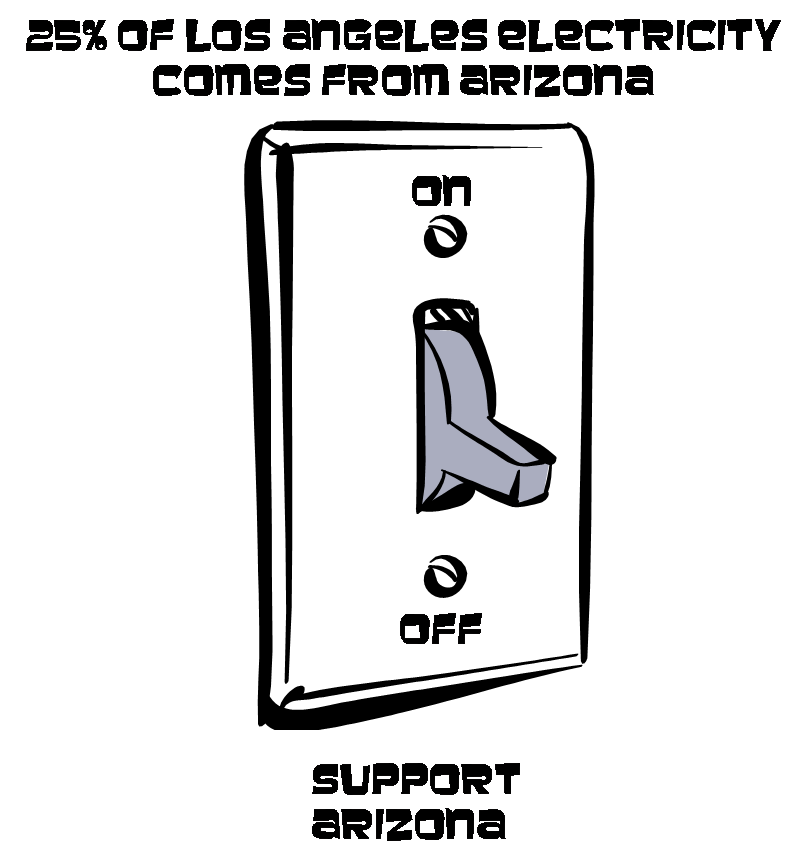There is a great editorial at copanews (that is Maricopa County News). I'm including it here in it's entirety. It has one flaw - it fails to note why the Yuma sector is so much more secure is that they have a fence and the border patrol quickly jails for two weeks you if you're caught once, 30 days the second time, and so forth.
E.M. Murray
With the controversy in the State of Arizona over illegal immigration -- particularly since the passage and signing into law of Senate Bill 1070 -- we have been inundated with news clips of angry people on both sides of the issue. We have also been lulled nearly to sleep by the talking heads on the evening news spouting figures about illegal immigration that have little or no meaning to us. Depending upon which television channel you watch, the numbers may even be different.
We hear one figure one day and a different figure another day. What is the real story behind the numbers? Does anyone have accurate figures? Are there any figures we can believe?
It is virtually impossible to obtain accurate figures, either for the number of undocumented aliens in the United States (for obvious reasons) or the cost to US citizens of having those undocumented aliens here. There are, however, credible sources who give numbers based on research instead of on emotion. This article will use those sources.
A publication from the Majority Staff of the House Committee on Homeland Security Subcommittee on Investigations, “A Line in the Sand: Confronting the Threat at the Southwest Border,” (www.house.gov/sites/members/tx10_mccaul/pdf/Investigaions-Border-Report.pdf), is a report that every concerned citizen should read. Don’t read it just before going to bed at night, though – it may give you nightmares.
The numbers
The United States shares nearly 6,000 miles of international border with Mexico and Canada. This article focuses on the US/Mexican border, since that is the area of interest to Arizonans. According to the report, during 2005, approximately 1.2 million illegal aliens were apprehended. Let’s see what that number actually looks like: 1,200,000. That is one of those numbers too large for most of us to really comprehend. Of those 1.2 million aliens, 165,000 were from countries other than Mexico (OTM). Of those 165,000, approximately 650 were from special interest countries (SIC).
Those special interest countries are a concern for both the United States and Arizona because they are “designated by the intelligence community as countries that could export individuals that could bring harm to our country in the way of terrorism” (quoted from a written statement of David Aguilar, Chief, Border Patrol, U.S. Department of Homeland Security).
The Tucson Sector of Border Patrol (the sector we reside in) is the busiest and biggest sector in the Border Patrol Service. It is so large and so busy that agents from other sectors are on loan to the Tucson Sector. According to Colleen Agle of the Tucson Sector, in the period of October 1, 2009 through July 31, 2010, there were 194,000 apprehensions in the sector. Border Patrol estimates (or guesstimates!) that for every one undocumented alien apprehended, 2.6 get away. Using that figure, 504,400 – over half a million -- entered the US through that one sector alone and were not caught. Those uncaught aliens could populate a city the size of Tucson. The Federal government estimates that only 10 to 30 percent of illegal aliens are apprehended, meaning that for the 194,000 caught in the Tucson sector, up to 1,746,000 came into the US illegally – and were not apprehended. That is a population the size of Phoenix!
Drugs, drugs, and more drugs
A large portion of illegal activity at the border has to do with illegal drug smuggling. In the fiscal year 2005, Federal drug seizures amounted to 222,714 kilograms (490,995 pounds or 245 and a half tons) of cocaine and 1,162,509 kilograms (over 2,562,867 pounds or more than 1,281 tons) of marijuana. So much for the “war on drugs.”
Pinal County numbers
What do the numbers have to do with us here in Maricopa? In 2009, the Pinal County Jail booked 325 illegal aliens. During much of the year, nation of origin was not recorded, but of those that were, there were 42 OTM undocumented aliens. Of those, two were from SICs – one from Cuba and one from Iran. Bear in mind that these people were not booked into the jail for being in the country illegally. They were booked for violations of law including DUI and extreme DUI, smuggling (people and/or drugs), assault with intent, child abuse, child molestation, aggravated assault on an officer, aggravated assault, theft, forgery, arson, identity theft, money laundering, kidnapping, unlawful flight from law enforcement, burglary, and just about any other crime one can think of.
From January 1, 2010 through June 30, 2010, the Pinal County Jail booked 191 undocumented aliens. Of those, 30 were OTMs. Of those 30, seven were NOIs, including one from Brazil and one from Colombia.
The Pinal County Sheriff’s Office (PCSO) called the U.S. Border Patrol 249 times in 2009 and 237 times in 2010 (as of August 9th). Many of those calls were for multiple persons.
The Pinal County Adult Detention Facility has an agreement to house illegal aliens, who are turned over to U.S. Immigration and Customs Enforcement (I.C.E.). In 2008, they housed 6,728 of these individuals. In 2009, that number was 6,549.
According to Pinal County Sheriff’s Office Public Information Officer Tim Gaffney, the cost to house a prisoner is $59.64 per person per day. Multiply the inmate numbers by $60 and you begin to see the staggering amounts of money spent. Is it any wonder that it seems like Sheriff Paul Babeu is always asking the Board of Supervisors for more money?
In addition to the obvious dangers to the citizens of the county due to crimes committed by undocumented aliens, there is another major issue. The majority of vehicle pursuits by the PCSO involve drug and human trafficking. These pursuits put everyone on the road at risk, both unsuspecting citizens and the deputies. In 2007, there were 142 vehicle pursuits in the county. In 2008, there were 140. In 2009, the number of vehicle pursuits was up to 289. Through (only!) July 31st of this year, there have been 246 pursuits. In some cases, the deputies have dropped pursuits when the risk to citizens was too high to warrant further pursuit. However, even ending a pursuit does not guarantee safety. (See http://www.copanews.com/Article.aspx?ID=1616 for an example.)
The human costs
In addition to threats, risks, and losses to the public due to crimes committed by illegal aliens, there are also human costs. Deaths in the desert are all too common. (Actually, even one death is too many.) The slow or infirm are often left behind by the “coyotes” (human traffickers) to make their own way – or die – in the desert. Through July 15, 2010, the Pima County Medical Examiner handled 134 deceased illegal immigrants (an increase from 93 last year). On October 6, 2010, The Washington Independent reported 252 bodies were recovered in Pima County. The office was so overloaded with bodies that the medical examiner had to get a refrigerated truck to store some of them. It is estimated that 2/3 of the deceased are never identified, leaving hundreds of families to worry and wonder about their loved one.
In Pinal County this year, through August 12, 2010, 12 bodies were recovered from the desert. While many of those people died of exposure, either to cold nights in the winter or heat in the summer, two were officially ruled as homicides. Five of the deceased have not been identified; their families will never know what became of them.
In addition, the television news has a story about a “drop house” nearly every week. Houses where men – and women -- and children – are held against their will, starved, and abused, while their families in Mexico are extorted to obtain their release.
Yuma Sector: doing the job
The Yuma Sector of Border Patrol, on the other hand, was bragging in September that they have had no border-crossing fatalities this fiscal year (www.YumaSun.com). In recent years, enforcement was stepped up in that sector. (Now-Sheriff Babeu was a participant in the increased Yuma Sector enforcement.) Border enforcement in the sector is so tight that word has gone out not to try to cross there. If you are caught, you will be summarily jailed and then deported. “Catch and release” is no longer the way things are done in Yuma Sector.
No money for enforcement
One problem Pinal County has in relation to being a “smuggling corridor” is that we are not technically a “border county.” Although trafficking, both human and drugs, is a serious problem in our county, and related violence is escalating (see http://www.copanews.com/Article.aspx?ID=1158), we are not included in funds for enforcement because we are not a “border county.” Washington cannot conceive that we would need enforcement funds – after all, we’re miles away from the US/Mexican border!
Arizona dollars
While the “FAIR Report” has been termed unfair by some, it offers a conservative estimate of the cost of Arizona’s illegal immigrant population. The organization’s estimate comes to about $1.3 billion per year – ONLY for education, medical care, and incarceration (http://www.fairus.org/site/PageServer?pagename=iic_immigrationissuecenters5e3f). In case that figure doesn’t impress you, it’s $1,300,000,000 of your tax money. This does not include a lot of other costs: displacement of legal workers by illegal immigrants willing to accept lower wages, law enforcement costs for prevention and enforcement and judicial process (court) costs, the need for bi-lingual employees in numerous industries, bi-lingual printing costs for documents (including voting materials), higher insurance rates associated with illegal immigration related crimes such as property loss and auto theft, US money sent to Mexico -- and on and on it goes.
The education costs do not include things such as ESL instruction and school nutrition programs. Look at the cost of supporting illegal aliens and then look at the Arizona State budget deficit; you may see a connection there.
Your family is paying (the figure may be considerably higher now) about $717 per year just to support illegal immigrants. If you don’t like the large class sizes at your child’s school, consider this: 15 to 20% of the students in his or her class are illegal immigrants. If you have ever been forced to wait for hours at the Emergency Room, be aware that the preferred medical provider of illegal immigrants (who will never pay the bill, by the way) is the Emergency Room. In addition, your medical bills are high in order to cover the cost of those who are uninsured and never pay.
Governor Brewer has taken a solid stand against illegal immigration in signing Senate Bill 1070. Sheriff Joe Arpaio of Maricopa County is still doing his raids to arrest illegal immigrants. Sheriff Paul Babeu of Pinal County has become a vocal opponent of illegal immigration due to recent crimes in our county. More and more states have passed or are passing laws similar to our SB 1070.
What you can do
When you go to the polling place on November 2 to exercise your right – and your responsibility – to vote, consider the platforms and the promises of the candidates. If you see illegal immigration as a problem for Pinal County and for Arizona, vote for those who see it the same way and say they will do something about it.
If you see people you suspect of being illegal aliens, call 9-1-1. The Pinal County Sheriff’s Office has authorization to apprehend undocumented aliens, who are then turned over to I.C.E.
Note: The Pinal County Sheriff’s Office was very cooperative and willing to help with research for this article and provided numerous facts, figures, and interviews. The local media has carried articles about illegal trafficking in Maricopa but when asked for data regarding stops of undocumented aliens by the Maricopa Police Department, we received the following communication from the Public Information Officer of the Department: “Per our Departmental policy we do not ask people whether they are undocumented aliens. Subsequently, we do not have stats surrounding those circumstances.” For this reason, there is no information specific to Maricopa in this article














No comments:
Post a Comment